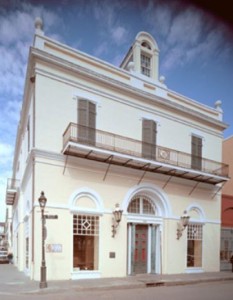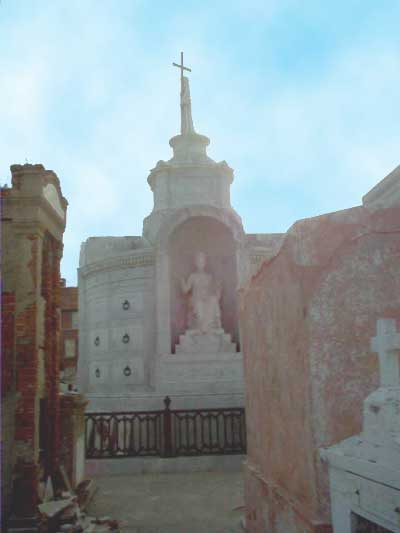Ahh the French Quarter, the backdrop of a hundred thousand mistakes
and regrets. Stories of love, passion, revenge, salvation, murder, God,
magic, monsters and everything in between, they all seem to play out so
well on this unique background. It's no wonder that this particular
section of New Orleans is a fountain of inspiration for artists of all
sorts, but especially writers. The two best examples of the gold the
French Quarter can produce are probably Tennessee Williams' ' A
Streetcar Named Desire' and John Kennedy Toole's 'A Confederacy of
Dunces' (we should note that a lot of the second book takes place on
Canal St., which is technically not the French Quarter but.... meh.).
I don't want to spoil either book, but 'Dunces' can be summed up as:
'Oh
Fortuna! Why hast thou spun me downward. My Boss hath told to stay out
of trouble...so a RIOT I shall start.Oohhh...nevermind there are
strippers..and birds..RIGHT HERE. This is awesome.'
While 'Desire' can be summed up thusly-
Also..you know..young Marlon Brando. You can watch him do anything. Eat a sandwich, channel surf, blink, whatever.
Anyway ARCHITECTURE.
So how does one house this passion? The best answer is uniquely.
The French quarter has it's own architectural standards that have persevered through flood, fire, famine and riot. There are a few kinds we want to touch on briefly. The first is the 'Shotgun House'. A Shotgun is thus named because, hypothetically, you can shoot a from the backdoor and the bullet should come out the front.
While extremely simple, the shotgun house ingeniously mixes function and economy. The straight row of doors allow for a quick cross ventilation of the house and is a natural fit for the linear plots of land that the original plan of the French Quarter encouraged (see previous post). You also essentially have two porches, one for the front and one for the back. I like this as a poetic interpretation of what you show to the world and what you really are.
There are several versions of this style, double shotgun, semi-detached, etc. The nicer ones have a kind of Colonial/Victorian molding which make them look like sweetest old lady in the world lives there. How can she afford it? The cute brigade pays her to have pies cooled on windowsills year round.
The next we want to cover is the Creole Townhouse
Creole townhouses are interesting because they attempt to blend Spanish and French Styles. The walls are the stucco and brightly painted colors of the Caribbean Colonies while the structure is a French post-and-brick. This technique does not rely too heavily on one material or the other, as in this climate, both can be unreliable. (Brick can sink, wood can burn). You might also notice a large number of Mansard roofs on the Creole townhouses in addition to the traditional Spanish-slate hipped. Additionally, most have a wrought iron balcony (or two depending on the exterior) that has come to be associated with much more lewd behavior than I think the original intent implies, especially on Bourbon St.
The other noticeable feature is the floor plan. On the first floor you might have a multi-use space like a shop or bar, with the apartments on top. In the greater homes, it will simply be a grand parlor for entertaining.
The interesting thing to note is how rarely the staircase is put out front and center. This is because only the closest guests are allowed upstairs. Along with the shotgun houses, we begin to see a pattern. The architecture implies a group of people who are easy to approach, but hard to know. Friendly and charming but also guarded and suspicious.
This changes when we are introduced to the "American Townhouses".
When the exotic northerners started congregating in New Orleans, they brought their northern ideas of townhomes with them. One idea was the somewhat strange notion (to them) that you would want main staircase to be a strong presence in your home. In colder climates this makes sense, as you are looking to condense space and expand fireplaces to retain heat. In a place like New Orleans, when it's so hot you feel like you are literally a walking ball of sweating lard, this makes less sense. However, fashion is as fashion does and the idea became popular.
Please note that the exterior of the houses stayed similar.
According to NOLA.gov, The Anglo-American Townhome can be also summed up thusly:
 "These townhouses were organized around the side hall which served as the
main entry to the house, as well as the chief means of internal
circulation. On the ground floor, the hall was flanked by the formal
rooms, the parlors and dining room, although in some cases the dining
room was placed at the end of the hall in the rear wing of the house.
Ascending the staircase to the second floor, one would find an
abbreviated hall that led to the bedrooms. The rear wing of the house
contained the kitchen and service rooms on the first floor and small
bedrooms on the second. It is generally significantly narrower than the
main house and contains no internal hallways."
"These townhouses were organized around the side hall which served as the
main entry to the house, as well as the chief means of internal
circulation. On the ground floor, the hall was flanked by the formal
rooms, the parlors and dining room, although in some cases the dining
room was placed at the end of the hall in the rear wing of the house.
Ascending the staircase to the second floor, one would find an
abbreviated hall that led to the bedrooms. The rear wing of the house
contained the kitchen and service rooms on the first floor and small
bedrooms on the second. It is generally significantly narrower than the
main house and contains no internal hallways."A good example of the French Quarter Townhomes is Latrobe's on Royal, designed by my one true love, Benjamin Henry Latrobe (Be still my heart).
LaTrobe is bringing the idea of 'Classical' proportions while maintaining the accessible nature of the area via the 'Carriage door'. The ceilings are high and vast, but the upstairs is removed and private.
Next there is the jewel of the Crescent City, St. Louis Cathedral on Jackson Square.
Frequenters of this blog will know that I give tours at "America's First Cathedral: The Baltimore Basilica." However, technically it's not true. St. Louis' was built in 1721 and while not initially distinguished as a 'Cathedral' it was a serious landmark for the citizens. The original design burned down in the fire of 1788 and a new church was built in 1789. It was afterwards designated as a Cathedral (1795). The Baltimore Basilica was not started until 1806, however, a technicality in timing allows Baltimore to slide in for the win, but just barely.
Original Design
The interior has all the working organs of any other Cathedral, apse, nave, transept, etc., What makes it interesting are the balconies. Unlike the Gothic churches on which this design is based, the second floor has deep porches that allow for less light, but more seating/standing space. This will make the stained glass much less impressive, but in a place with massive heat gain, it makes sense to have a little less light and much more in terms of wall decoration.
The higher windows also allow for better ventilation.
Finally, because it is one of the coolest spots in the city, there is the above ground cemetaries. Some would say that the graves are not architecture as much as they are an interpretation or mimicry of architecture. To that I say:
Booyah.
Cemetary #1 was started in 1789 after the aforementioned fire of 1788 ripped through the city. The idea of the above ground cemetary was adopted by the Spanish and made sense for two grisly reasons.
#1: The soil is basically playdough, so eventually the graves may come up, embarrasing the dead and freaking out the living, it's best to just avoid the whole thing.
#2: The mosoluems get so hot that people can litterally fry up in there, which basically creamates the bodies. Allowing for more people to be buried in the same plot. Convienient without being disrespectful.
The layout of the cemetaries (especially #1) is meandering and a little confusing, but also strangely organized, a messy desk, but you know where you put that thing. The whole place is peaceful, poetic and inherently creepy, but in a charming way.
Like this lady right here.
There are many interesting people who came to rest in this cemetary. Including, sadly,
Also, this guy, Barthelemy Lafon, who I think deserves another Love Letter...and soon.
So we've got the basics, but what is the Quarter really like? Like it's history, it's a lot of things to a lot of different people. Touristy? Sure. Charming? Yes, that's why there are so many tourists. Gross, dirty and wrong? Only if you want it to be. The French Quarter knows who she is. You can love her or leave her, but you never forget her.
Plus, everywhere you go has amazing music.
The only criticism I have of the French Quarter is that it is almost too perfect. Most of the homes are monitored closely to ensure their historic significance is preserved, so much so that it kills all chance of it evolving further. These places have survived in the truest sense of the word but will now be in a state of arrested development, creating a paradox of a place that is both experienced and untouched by time. Then again, maybe we overrate the new, after all, as Ignatius once said:
"Possession of anything new or expensive only reflected a person's lack of theology and geometry; it could even cast doubts upon one's soul"
NEXT TIME ON NEW ORLEANS: Plantations, Piazzas, Public Buildings and other things that go "bump" in the night.
NEXT TIME ON NEW ORLEANS: Plantations, Piazzas, Public Buildings and other things that go "bump" in the night.















Love this post on New Orleans. Especially the photo of the Latrobe tomb.
ReplyDeletePlease do write that Love Letter to Lafon - I'd enjoy reading it. (I'm researching him at the moment.) were you able to find his grave?
No, sadly. I really wished I could have found Lafon. I actually looked forever for the Latrobe tomb, which was in an obvious place once I found it. Stay posted, we've got a series of new Loveletters coming soon. Thanks for reading!
ReplyDelete